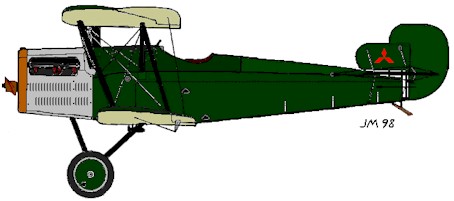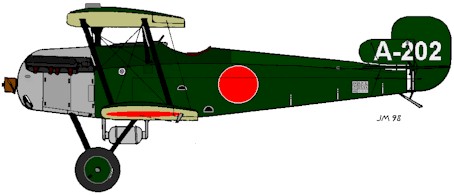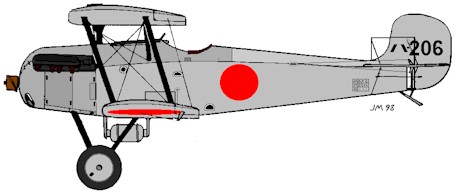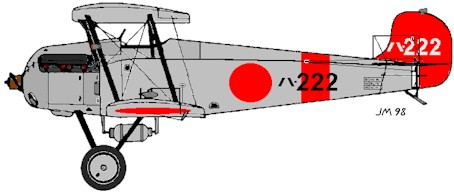Mitsubishi Type 10 Carrier Fighter Brief history of the Type 10 by Johan Myhrman In 1921 Herbert Smith was invited to Nagoya to help Mitsubishi in develop what would not only be the worlds first purposely designed carrier fighter, but also the first airplane to land and take off from the worlds first purposely designed aircraft carrier: the Mitsubishi Type 10 fighter (1921 was the 10:th year of the emperor Taisho's regime). Smith was Mitsubishi's prime choice as he had earlier designed the successful Sopwith Pup and the Sopwith Triplane. The 1MF was fighter of classic design, cloth covered wooden structure with two 7.7 machineguns. A 300 hp Hispano Suiza 300 hp 8 cylinder V water cooled engine powered the aircraft's which could keep airborne for 150 minutes. The first prototype was completed in October 1921 and had a honeycomb radiator in front of the engine. The new fighter was successfully tested and accepted by the Navy as a replacement for the Gloster Sparrowhawk the following month. The Type 10 served with operational units from 1923 until 1930 when it was replaced by the Nakajima A1N Type 3 fighter. The production version of the airplane had the honeycomb radiator replaced by Lamblin radiators which Mitsubishi got the manufacturing rights for in 1923. The radiators were two small drums with cooling fins placed bellow the wing. The redesign gave the fighter a more pointed and streamlined nose. A total of 138 Type 10 fighters were built between 1921 and 1929. The last ones being trainers. To enable carrier landings the Type 10 was equipped with claws mounted on the wheel axles. The claws were designed to grab the arresting wires on the carrier Hosho. The wires were in British style for the period running from the bow to the stern. The idea behind this was that the wires would guide the aircraft when landing and prevent it from steering off course. Additional wires were also stretched across the deck to help stop the plane. The bow-stern wire arrangement was not very reliable and were soon deleted. The first take off and landing on the Hosho was made February 28 1923 by William Jordan, who was a member of Herbert Smith's team. For this achievement Jordan earned 10.000 Yen (15.000 according to some sources), never the less a huge amount of money in 1923. A month later Shunichi Kira became the first Japanese aviator to land on the carrier. Profiles The Type 10 fighter went through a development phase during it's active life that resulted in several subtypes. The subtype designations are a little bit complicated. To start there are two basic types, the 1MF-1 with the Honeycomb radiator and the 1MF-2 with the Lamblin radiator. Among the 1MF-1's there are three main subtypes. The first being the first prototype, the 1MF1 as seen bellow. The prototypes were painted in green leaving the aluminum engine panels bare. The under sides were clear doped giving a tan color. Wing and wheel struts were black and white lift markings were painted on the rear fuselage. At delivery of the first prototypes, the Mitsubishi three diamond insignia was painted on the tail. The manufactory data plate that is usually found under the tail plane seems to be missing on the first 1MF1's.
Typical of the 1MF1 was the "ear" or extended ailerons similar to the Fokker DVII. These were deleted on the 1MF1A when the wing was extended. The final 1MF-1 subtype was the 1MF2 that had an increased tail area and a two bay wings, i.e four wing struts. The air louvers configuration changed through the prototypes to finally be replaced by four large square air vents. The Type 10 fighters that went into production were all 1MF-2's. The first subtype being the 1MF3 with the honeycomb radiator replaced by the Lamblin type. The profile bellow shows a 1MF3 from the aircraft carrier Hosho. The "A" carrier identification code was used until 1926 when it was replaced by Katakana.
The 1MF3 was further developed by redesign of the exhaust manifold changing how the engine covers were fastened. The tail area was redesigned removing the last visual Sopwith influence. The entrance point for the horizontal rudder wires was moved forward on the fuselage when this was done. The stitched joint running midway along the aft fuselage was also deleted. The arresting wire hooks were probably also moved from the wheel axles to the rear landing strut. Bellow is a 1MF3A on the carrier Akagi. The 1MF was used on the Akagi from 1927 and from the Kaga in 1928. The airplane is overall silver/grey and the black identification code is carried on the tail, upper wing and repeated on both the right and left lower wing area.
Radical changes were made for the 1MF4 subtype by moving the cockpit forward and changing the wing stager to compensate for the weight shift. The engine covers were also slightly modified. Bellow is a 1MF4 (or possible a 1MF5) in the late 1920:ies also from the Akagi. Note that the identification code numbers are hypothetical. Red tail and fuselage band has been added as well as black identification code repeated on the rear fuselage, the tail code being white. The navigation light on the wing struts and vertical tail were added already on the 1MF3's.
The final subtype was the 1MF5 with minor changes. There was also a 1MF5A which was a trainer with enlarged wing area for safer carrier landings. They were equipped with floats beneath each wing and jettisonable undercarriage in case of emergency landing on water. Some 1MF5A'a even had an extra aileron mounted between the top and lower wings. Profile references
|



